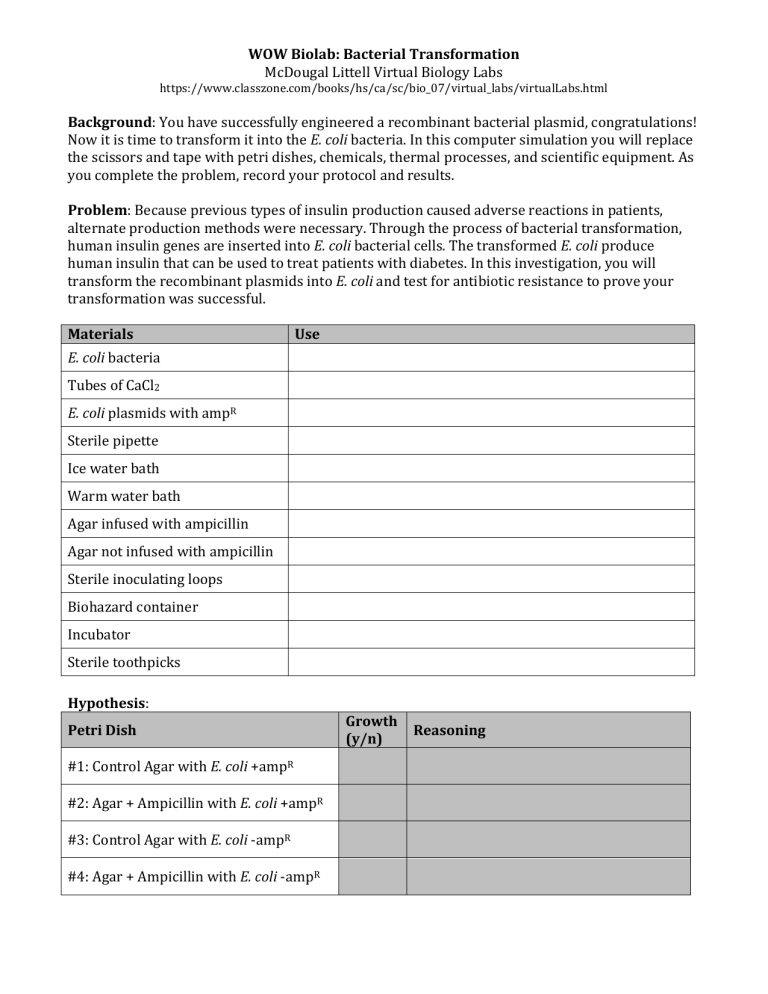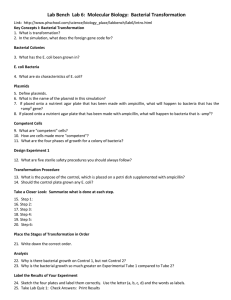39. Bacterial Transformation Lab Notebook.doc

WOW Biolab: Bacterial Transformation
McDougal Littell Virtual Biology Labs https://www.classzone.com/books/hs/ca/sc/bio_07/virtual_labs/virtualLabs.html
Background: You have successfully engineered a recombinant bacterial plasmid, congratulations!
Now it is time to transform it into the E. coli bacteria. In this computer simulation you will replace the scissors and tape with petri dishes, chemicals, thermal processes, and scientific equipment. As you complete the problem, record your protocol and results.
Problem: Because previous types of insulin production caused adverse reactions in patients, alternate production methods were necessary. Through the process of bacterial transformation, human insulin genes are inserted into E. coli bacterial cells. The transformed E. coli produce human insulin that can be used to treat patients with diabetes. In this investigation, you will transform the recombinant plasmids into E. coli and test for antibiotic resistance to prove your transformation was successful.
Materials Use
E. coli bacteria
Tubes of CaCl
2
E. coli plasmids with amp R
Sterile pipette
Ice water bath
Warm water bath
Agar infused with ampicillin
Agar not infused with ampicillin
Sterile inoculating loops
Biohazard container
Incubator
Sterile toothpicks
Hypothesis:
Petri Dish
#1: Control Agar with E. coli +amp R
Growth
(y/n)
Reasoning
#2: Agar + Ampicillin with E. coli +amp R
#3: Control Agar with E. coli -amp R
#4: Agar + Ampicillin with E. coli -amp R
Record your protocol:
Step 1:
Step 2:
Step 3:
Quick Check: What does Tube 1 ( CaCl
2
) have that Tube 2 ( CaCl
2
) doesn’t?
Step 4:
Step 5:
Step 6:
Step 7:
Step 8:
Step 9:
Step 10:
Step 11:
Results:
Petri Dish
#1: Control Agar with E. coli +amp R
#2: Agar + Ampicillin with E. coli +amp R
#3: Control Agar with E. coli -amp R
Growth (Quantify and Qualify)
#4: Agar + Ampicillin with E. coli -amp R
Analyze:
1.
What does the genome of a transformed E. coli cell contain that they normal E. coli doesn’t?
How can you tell which, if any, were transformed?
2.
Compared with Petri Dish 1, what does Petri Dish 2 tell you about whether all of the bacteria cells incorporated the amp R gene?
3.
How does Petri Dish 4 support the conclusion that some bacterial cells did take in the amp R gene? (Hint: Compare to Petri Dish 2)

